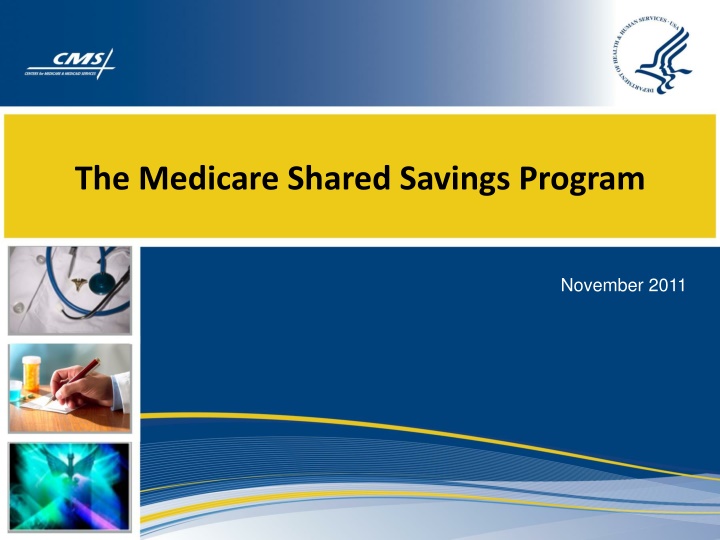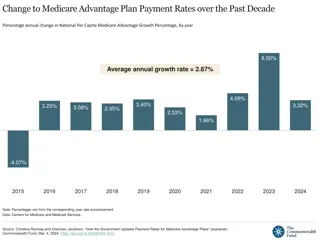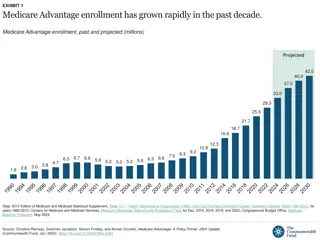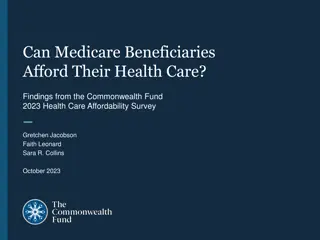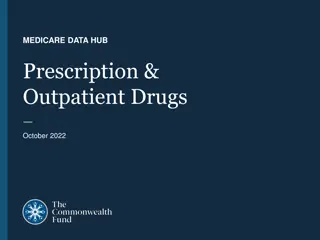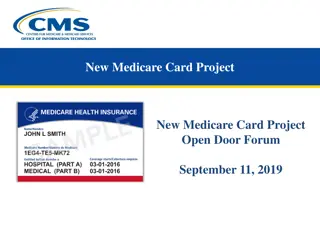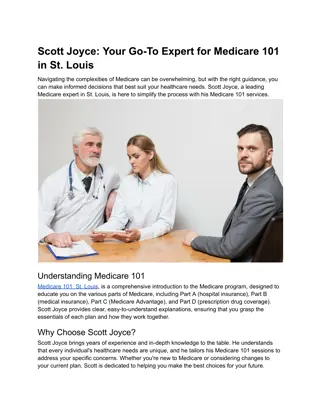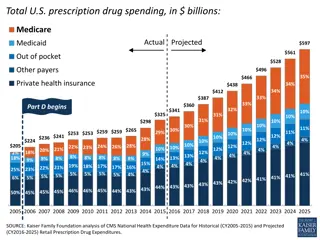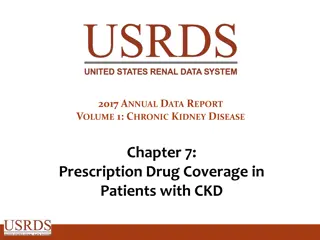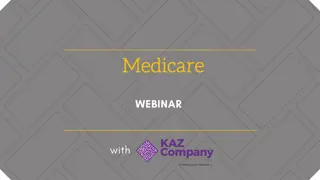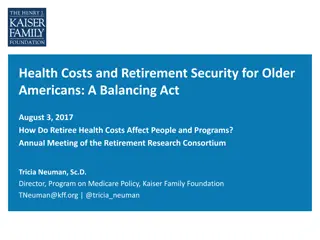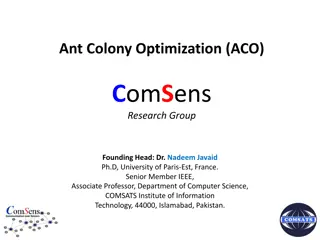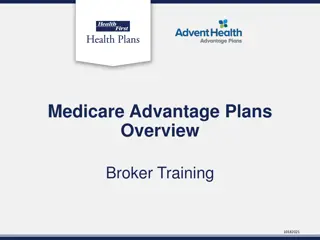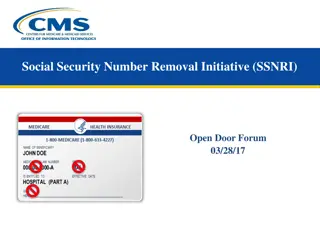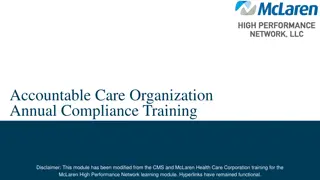Overview of Medicare ACO Models
The Medicare Shared Savings Program offers various ACO models such as the Basic Track with one-sided and two-sided risk/reward structures, the Enhanced Track with higher risk/reward levels, the ACO Investment Model focusing on rural areas, and the Advance Payment ACO Model for physician-based providers. The Next Generation ACO Model aims to improve health outcomes by incentivizing ACOs and enhancing patient engagement.
Download Presentation

Please find below an Image/Link to download the presentation.
The content on the website is provided AS IS for your information and personal use only. It may not be sold, licensed, or shared on other websites without obtaining consent from the author.If you encounter any issues during the download, it is possible that the publisher has removed the file from their server.
You are allowed to download the files provided on this website for personal or commercial use, subject to the condition that they are used lawfully. All files are the property of their respective owners.
The content on the website is provided AS IS for your information and personal use only. It may not be sold, licensed, or shared on other websites without obtaining consent from the author.
E N D
Presentation Transcript
The Medicare Shared Savings Program November 2011
Overview 2
ACO Vision An ACO promotes seamless coordinated care Puts the beneficiary and family at the center Remembers patients over time and place Attends carefully to care transitions Manages resources carefully and respectfully Proactively manages the beneficiary s care Evaluates data to improve care and patient outcomes Innovates around better health, better care and lower growth in costs through improvement Invests in team-based care and workforce 3
CMSs ACO Strategy: Creating Multiple Pathways with Constant Learning and Improving MSSP: Track 1 & Track 2 Pioneers AdvancePayment 4
Operating Principles Creating multiple pathways and on-ramps for organizations to participate Strong data partnership Beneficiary notification and engagement Maintain strong partnership with federal anti-trust agencies Robust quality measurement and performance monitoring Stronger business case to participate Excitement and momentum 5
Proposed vs. Final Rule Topic Transition to risk in Track 1 Proposed Rule Choose from two 3-year tracks. Track 1 would comprise 2 years of one-sided shared savings with a mandatory transition in year 3 to two- sided risk model of shared savings and losses. Track 2 would comprise 3 years all under the two-sided model. Retrospective assignment based on utilization of primary care services, with prospective identification of a benchmark population. Modifications in Final Rule Remove two-sided risk from Track 1. Two tracks would still be offered for ACOs at different levels of readiness, with one providing higher sharing rates for ACOs willing to also share in losses. A preliminary prospective- assignment method with beneficiaries identified quarterly; final reconciliation after each performance year, made on the basis of patients served by the ACO. Prospective vs. Retrospective assignment 6
Proposed vs. Final Rule Topic Proposed measures to assess quality Proposed Rule 65 measures in 5 domains, including patient experience of care, utilization claims based measures, and measures assessing process and outcomes. Pay for full and accurate reporting first year, pay for performance in subsequent years. One-sided risk model: sharing beginning at savings of 2%, with some exceptions for small, physician-only, and rural ACOs. Two-sided risk model: sharing from first dollar. Modifications in Final Rule 33 measures in 4 domains. (Note: Claims- based measures not finalized to be used for ACO-monitoring purposes.) Longer phase-in of measures over course of agreement: first year, pay for reporting; second and third years, pay for reporting and performance. Share on first dollar for all ACOs in both models once minimum savings rate has been achieved. Sharing savings 7
Proposed vs. Final Rule Topic Sharing beneficiary identification claims data Proposed Rule Claims data shared only for patients seen by ACO primary care physician during performance year; beneficiaries given opportunity to decline at the point of care. The four groups specified by the Affordable Care Act, as well as critical access hospitals paid through Method II, are eligible to form an ACO. ACOs can be established with broad collaboration beyond these providers. Modifications in Final Rule The ACO may contact beneficiaries from provided quarterly lists to notify them of data sharing and opportunity to decline. In addition to groups included in the proposed rule, Federally Qualified Health Centers and Rural Health Clinics are also eligible to both form and participate in an ACO. Eligible entities 8
Proposed vs. Final Rule Topic Start date Proposed Rule Agreement for 3 years with uniform annual start date; performance years based on calendar years. Reports will be provided at the beginning of each performance year and include: name, date of birth, sex, and health insurance claim number. Modifications in Final Rule Program established by January 1, 2012; first round of applications are due in early 2012. First ACO agreements start April 1, 2012, and July 1, 2012. Additional reports will be provided quarterly. Aggregate reports and preliminary prospective list 9
Proposed vs. Final Rule Topic Proposed Rule Modifications in Final Rule 50% of primary care physicians must be defined as meaningful users by start of second performance year. One-step assignment process: beneficiaries assigned on the basis of a plurality of allowed charges for primary care services rendered by primary care physicians No longer a condition of participation. Retained EHR as quality measure but weighted higher than any other measure for quality-scoring purposes. Two-step assignment process: Step 1: for beneficiaries who have received at least one primary care service from a physician, use plurality of allowed charges for primary care services Step 2: for beneficiaries who have not received any primary care services from a physician, use plurality of allowed charges for primary care services rendered by any other ACO professional. Electronic health record (EHR) use Assignment process 10
Proposed vs. Final Rule Topic Marketing guidelines Proposed Rule All marketing materials must be approved by the Centers for Medicare and Medicaid Services. Modifications in Final Rule File and use 5 days after submission and after certifying compliance with marketing guidelines; CMS to provide approved language. 11
Proposed vs. Final Rule Topic Coordination with Antitrust Agencies (DOJ/FTC) Proposed Rule Proposed that the ACO meet certain clinical integration criteria in order to be eligible for participation. Also proposed ACOs undergo review by an Antitrust Agency if certain market power thresholds are met. Modifications in Final Rule Maintain policy goal, but modify the process to address legal concerns. Provide for a voluntary review process and clinical integration criteria. Worked with FTC/DOJ to streamline our requirements while ensuring ACOs can participate without running afoul of antitrust laws. 12
Questions? 13
Appendix: Financial Model Topic Proposed Rule Final Policy One-Sided Risk Model Two-Sided Risk Model Sharing Rate Finalize our proposal for establishing the MSR which protects the trust fund from paying out incentives for normal variations in cost rather than for real improvements made by the ACO. Up to 52.5%, sliding scale based on quality performance and inclusion of FQHC/RHCs One-Sided Model Up to 65%, sliding scale based on quality performance and inclusion of FQHC/RHCs Two-Sided Model Modify our proposals to: Eliminate the 2.5% and 5% FQHC/RHC add on but continue to make the two-sided model more attractive for organizations willing to take on performance-based risk. Minimum Savings Rate (MSR) Varies according to number assigned Flat 2% One-Sided Model 7.5% Two-Sided Model 10% Performance Payment Cap Increase the cap on shared savings (to 10% and 15%, respectively). One-Sided Model Sharing from 2% with some exceptions for small, physician only, and rural ACOs Two-Sided Model Sharing from first dollar Sharing from 2% Share on first dollar for all ACOs in both models once the MSR has been overcome. 14
Appendix: Financial Model Topic Proposed Rule Final Policy Proposed using prospective HCC risk scores to adjust for beneficiary characteristics in both benchmark and performance years. We further proposed to cap the risk adjuster at zero growth. Modify recommendation to use prospective HCC risk scores to allow for increases in risk scores for newly assigned beneficiaries each year. For beneficiaries that are continuously assigned, demographic factors only will be used to adjust risk scores - unless the HCC risk score declines for the group, in which case it will be reset at the lower score. HCC Risk Adjustment and Cap Proposed not to adjust the benchmark for IME/DSH or any other payments. Modify recommendation to adjust both the benchmark and performance year expenditures for IME/DSH payments. IME/DSH Adjustments Proposed setting a benchmark based on the expenditures of beneficiaries who would have been assigned to the ACO in each of the 3 years prior to the start of an agreement period. Finalize our proposal to set a benchmark based on the expenditures of beneficiaries who would have been assigned to the ACO in each of the 3 years prior to the start of an agreement period. Benchmarking methodology 15
